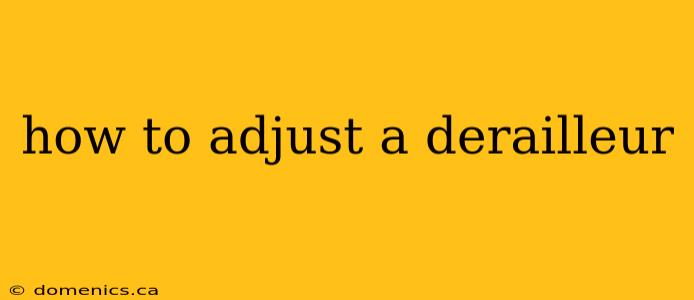Meta Description: Learn how to adjust your bike derailleur with our comprehensive guide! We cover troubleshooting common issues like chain skipping, derailleur hanger misalignment, cable tension, and limit screws. Get back on the road with smooth shifting! (158 characters)
Understanding Your Derailleur
Before diving into adjustments, let's understand what a derailleur does. Your derailleur is the mechanism that moves your chain between your different gears (cassettes in the back, chainrings in the front). Proper derailleur adjustment ensures smooth, efficient shifting. There are two main types: front and rear. This guide focuses primarily on the rear derailleur, as it's more commonly adjusted.
Types of Derailleurs
- Rear Derailleur: This is the derailleur located at the back of your bike, near the cassette. It moves the chain across the different cogs on the cassette, changing your gear ratios.
- Front Derailleur: Located near the chainrings on the crankset, it moves the chain between the different chainrings. Front derailleur adjustment is slightly different and often requires more specialized tools.
Common Derailleur Problems & Solutions
Several issues can indicate a need for derailleur adjustment. Identifying the problem helps you target the right solution.
1. Chain Skipping
This is a frequent problem. The chain may jump between gears unexpectedly or fail to shift smoothly. Causes include incorrect cable tension, misaligned limit screws, or a bent derailleur hanger.
2. Shifting Too Slowly
Sometimes, the chain responds sluggishly to shifting. This is usually because of cable tension or internal friction in the derailleur.
3. Chain Falling Off
The chain may fall off the cassette, indicating a problem with the limit screws or cable tension. It could also mean the derailleur hanger is bent.
4. Ghost Shifting
This is where the derailleur shifts unexpectedly without you actuating the shifter. This often points to cable tension problems or a damaged derailleur cable.
Tools You'll Need
Before you start, gather these essential tools:
- Screwdrivers: Phillips head and flathead screwdrivers are typically needed.
- Allen Wrenches: Various sizes, commonly 5mm and 4mm, are essential for adjusting limit screws and cable tension.
- Cable Cutters: To trim excess cable.
- A Bike Stand (Optional but Recommended): Makes the job significantly easier.
- Shifting Cable Housing Cutter: This specialized tool provides a clean cut, preventing frayed ends and easier cable insertion.
- Shifting Cable and Housing (if needed): If the cables are damaged or frayed, they'll require replacing.
How to Adjust Your Rear Derailleur: A Step-by-Step Guide
These instructions are general; refer to your bike's manual for specifics.
1. Assessing the Derailleur Hanger
Start by carefully inspecting the derailleur hanger. This small metal piece connects the derailleur to the frame. A bent hanger will cause misalignment and prevent smooth shifting. If bent, it needs replacement, as this is the most frequent cause of shifting problems, often overlooked. A Park Tool DAG-2.2 is a great tool to check for bent hangers.
2. Adjusting the Cable Tension (Barrel Adjuster)
Your derailleur will have a barrel adjuster near the cable clamp. Turning it clockwise will increase tension and counterclockwise will decrease it. Small adjustments here can often fix minor shifting issues. Experiment in small increments and test the shifting after each adjustment.
3. Setting the Limit Screws
The H and L screws (High and Low) determine the derailleur's range of motion. The high limit screw prevents the derailleur from shifting too far to the largest cog. The low limit screw prevents the derailleur from shifting too far to the smallest cog. Use your Allen wrench to adjust these. Always shift to the largest cog first and adjust the high limit, then shift to the smallest cog and adjust the low limit. This should ensure the chain is not on the extreme limits.
4. Fine-Tuning with Cable Tension
If the chain still skips or doesn't shift correctly, you might need to adjust the cable tension again. Loosen the cable clamp, turn the barrel adjuster, then tighten the cable clamp.
Troubleshooting Specific Problems
Here's how to tackle specific shifting problems:
How do I fix chain skipping on the largest cog?
Adjust the high limit screw. This prevents the derailleur from moving too far to the right.
How do I fix chain skipping on the smallest cog?
Adjust the low limit screw. This prevents the derailleur from moving too far to the left.
How do I adjust my front derailleur?
Front derailleur adjustment is more complex and involves adjusting the high and low limit screws, cable tension, and often requires aligning the derailleur with the chainrings using different screws. This usually needs more experience and is best performed with the aid of a bike repair guide specific to your bike's make and model.
When to Seek Professional Help
If you've tried these steps and are still experiencing problems, consider seeking assistance from a professional bicycle mechanic. They have the expertise and tools to diagnose and fix more complex derailleur issues.
Maintaining Smooth Shifting
Regular cleaning and lubrication of your drivetrain are key to maintaining smooth shifting and preventing more complex adjustments.
By following these steps and understanding the common issues, you can effectively adjust your derailleur and ensure your bike is shifting smoothly and efficiently! Remember to always consult your bike's manual for specific instructions.
